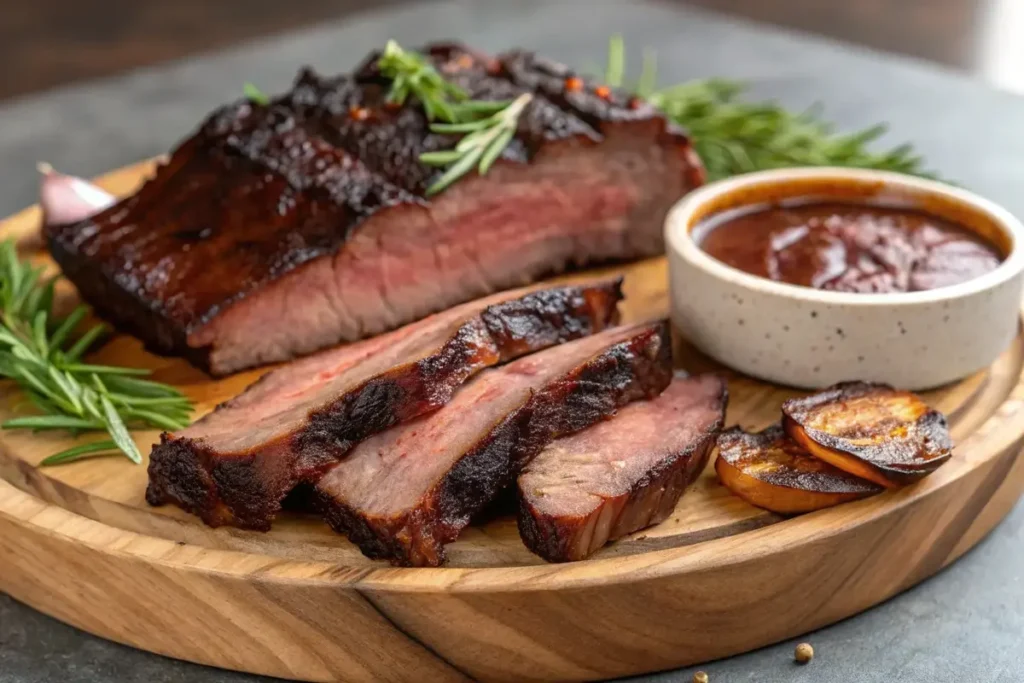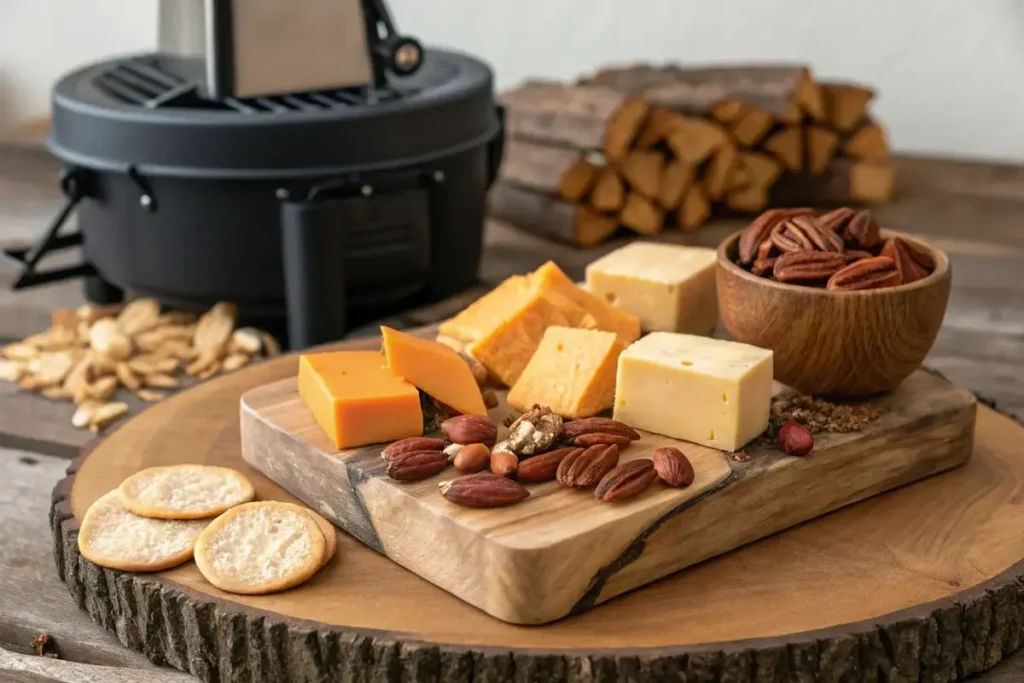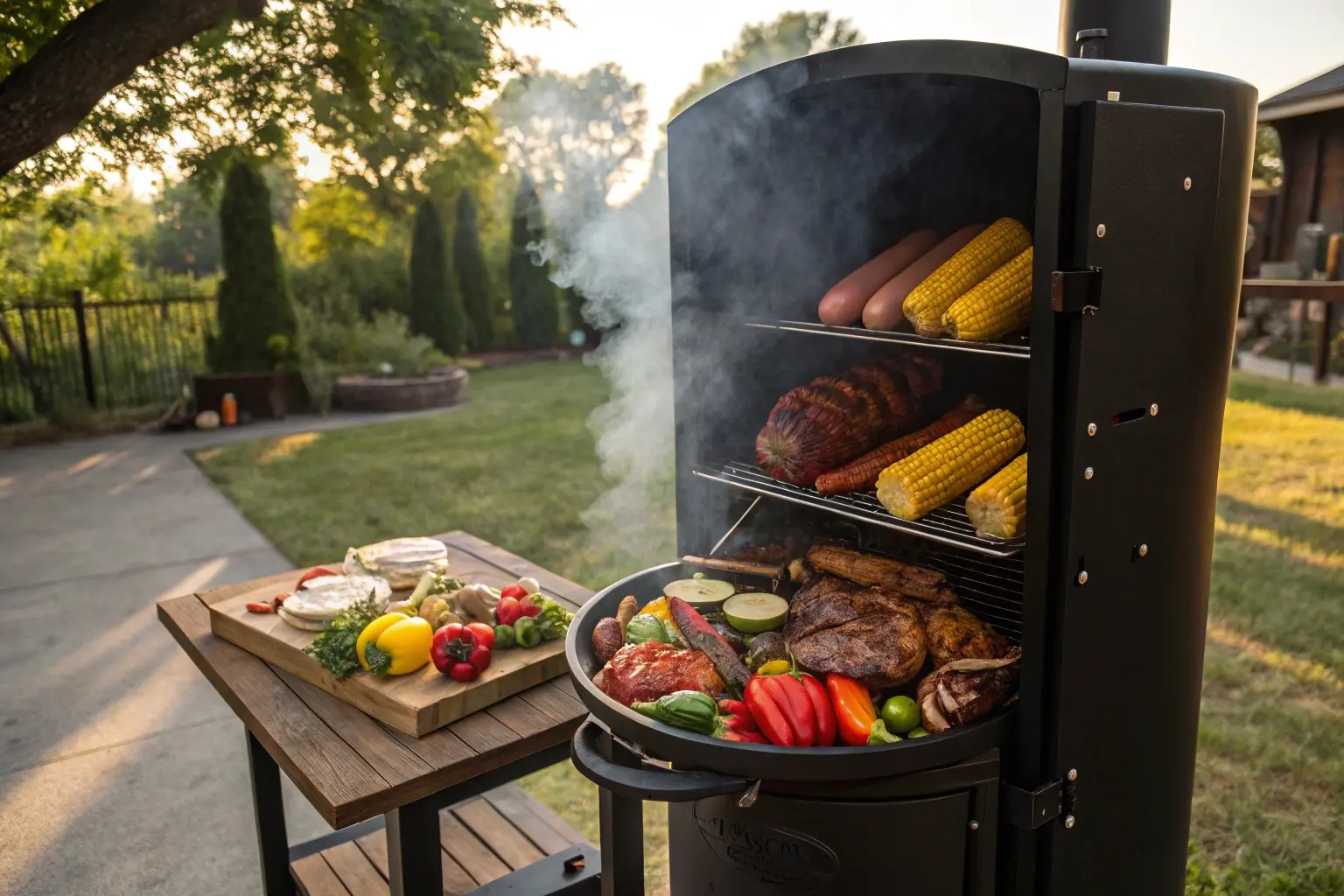Introduction
Smoking food has become a beloved culinary art, blending patience with bold flavors to create unforgettable meals. From meats and seafood to vegetables and even unconventional items like nuts and cheese, the variety of foods you can smoke is endless. This guide will dive deep into what is the best stuff to smoke, highlighting ideal choices for beginners and experts alike, essential techniques, and tips for achieving mouthwatering results. Let’s start with the basics of the smoking process and what makes it so special.
Understanding the Smoking Process
The Science Behind Smoking Food
Smoking combines heat and flavorful wood smoke to cook food while infusing it with a unique taste. It’s not just about cooking; it’s about transformation.
- Hot Smoking vs. Cold Smoking:
- Hot Smoking: Cooks food at higher temperatures (225°F–275°F) while adding smoky flavor. Perfect for meats, poultry, and vegetables.
- Cold Smoking: Infuses food with smoke at low temperatures (less than 90°F) without cooking. Ideal for items like cheese and fish.
- How Smoke Works:
The smoke from hardwoods breaks down into tiny particles that adhere to the surface of food, creating a rich, savory flavor. The longer the exposure, the deeper the flavor becomes.
Essential Equipment for Smoking
Your smoker setup can make or break your smoking experience. Choosing the right tools ensures success.
- Types of Smokers:
- Offset Smokers: Traditional and versatile, offering separate fireboxes for indirect smoking.
- Electric Smokers: Beginner-friendly and consistent, perfect for controlled smoking sessions.
- Pellet Smokers: Combine convenience with flavor by using wood pellets for consistent smoke.
- Charcoal Smokers: Deliver unmatched smoky flavor but require more effort to maintain temperature.
- Must-Have Accessories:
- Thermometers: A must for monitoring both smoker and food temperatures.
- Wood Chips or Chunks: Choose based on the flavor profile you want to achieve.
- Water Pan: Helps regulate temperature and adds moisture to prevent food from drying out.
Best Meats for Smoking
Top Choices for Smoked Meats
Smoking meat is the heart of barbecue culture, turning cuts into tender, flavorful dishes that delight the senses. Here are the top choices for smoked meats and how to prepare them for optimal results.
Beef Brisket
- Why It’s a Favorite Among Pitmasters:
Beef brisket is prized for its marbled fat and connective tissue, which break down during smoking to create tender, flavorful meat. The long cooking time allows the smoky flavor to penetrate deeply. - Tips for Smoking the Perfect Brisket:
- Preparation: Trim excess fat, leaving about a ¼-inch layer to keep the meat moist. Apply a dry rub of salt, pepper, and garlic powder.
- Smoking: Set the smoker to 225°F and use oak or hickory wood for bold flavors. Smoke for 10–12 hours, aiming for an internal temperature of 195°F–205°F.
- Resting: Let the brisket rest for at least an hour before slicing to retain juices.
Pork Shoulder (Pulled Pork)
- Flavor Profile and Ideal Smoking Conditions:
Pork shoulder, also known as Boston butt, is a forgiving cut with rich marbling, making it perfect for slow smoking. - How to Achieve Tender, Juicy Pulled Pork:
- Seasoning: Coat the pork with a mustard base and generously apply a spice rub.
- Smoking: Maintain a smoker temperature of 225°F–250°F, using applewood or cherry wood for a slightly sweet flavor. Smoke for 8–10 hours, until the internal temperature reaches 200°F.
- Pulling: Shred the pork with forks and mix in the smoky juices for enhanced flavor.
Ribs (Pork and Beef)
- Differences Between Pork and Beef Ribs:
- Pork ribs (baby back or spare ribs) are smaller and cook faster, offering a sweet and smoky profile.
- Beef ribs are larger with a robust, beefy flavor, requiring more time to tenderize.
- Techniques for Smoking Ribs to Perfection:
- Remove the membrane from the back of the ribs for better smoke absorption.
- Use a dry rub tailored to your preference—sweet for pork, savory for beef.
- Apply the 3-2-1 method: Smoke unwrapped for 3 hours, wrap in foil with liquid for 2 hours, and finish unwrapped for 1 hour.
Chicken and Turkey
- Benefits of Smoking Poultry:
Poultry absorbs smoke flavor quickly and cooks faster than other meats, making it ideal for beginners. - Brining and Seasoning Methods for Optimal Flavor:
- Brine the bird overnight in a mixture of water, salt, and sugar to enhance moisture.
- Season with a dry rub or marinade. Smoke at 250°F using fruitwoods like apple or cherry for a subtle sweetness.
Lamb and Game Meats
- Unique Flavors of Smoked Lamb and Game:
Lamb and game meats like venison offer rich, earthy flavors that pair well with smoke. - Special Considerations When Smoking These Meats:
- Use herb-based rubs with rosemary and thyme to complement their natural taste.
- Smoke at 225°F, using oak or pecan wood for a balanced flavor. Monitor closely to avoid overcooking.

Seafood Delicacies for Smoking
Best Seafood to Smoke
Seafood is a fantastic choice for smoking due to its ability to absorb flavors quickly. From fish fillets to shellfish, smoking elevates these delicate proteins to gourmet levels.
Salmon
- Ideal Smoking Techniques for Salmon:
- Preparation: Brine the salmon in a mixture of water, salt, and brown sugar for an hour. Pat dry and season lightly with dill and lemon zest.
- Smoking: Use alder wood for a mild, sweet flavor. Smoke at 180°F–200°F for 1.5–2 hours until the internal temperature reaches 145°F.
- Recipe Ideas and Serving Suggestions:
Serve smoked salmon on bagels with cream cheese or incorporate it into salads and pasta dishes for a flavorful twist.
Trout and Other Fish
- Smoking Methods for Various Fish Types:
Trout, mackerel, and snapper are great choices. Smaller fish can be smoked whole, while larger ones are best filleted. - How to Prevent Overcooking Delicate Fish:
Maintain a consistent smoker temperature of 175°F–200°F and monitor closely. Smoke for 1–2 hours, depending on the thickness of the fish.
Shellfish (Shrimp, Scallops, Mussels)
- Quick-Smoking Techniques for Shellfish:
- Marinate shrimp and scallops in olive oil, garlic, and paprika.
- Smoke shellfish on skewers or in a grill basket at 225°F for 30–45 minutes.
- Enhancing Natural Flavors with Smoke:
Use mild woods like maple or pecan to bring out the shellfish’s sweetness. Serve as appetizers or pair with pasta for a luxurious meal.
Vegetables and Fruits Suitable for Smoking
Smoking Vegetables for Enhanced Flavor
Vegetables are fantastic for smoking, as the process intensifies their natural sweetness and adds a subtle, smoky complexity.
Peppers, Onions, and Garlic
- How Smoking Intensifies Their Flavors:
Smoking enhances the natural sweetness of bell peppers, gives onions a caramelized depth, and transforms garlic into a smoky, creamy delight. - Uses in Recipes After Smoking:
- Smoked peppers can be pureed into sauces, added to salads, or used in fajitas.
- Smoked onions are perfect for soups, dips, or as a burger topping.
- Smoked garlic can be spread on bread, mashed into butter, or added to pasta dishes for a burst of flavor.
Smoking Tip: Use applewood or cherry wood for a mildly sweet smoke. Keep the smoker at 225°F and smoke for 30–60 minutes.
Root Vegetables (Potatoes, Carrots)
- Smoking Times and Seasoning Tips:
- Slice potatoes and carrots into even pieces for faster cooking.
- Toss them in olive oil, salt, pepper, and rosemary for added flavor.
- Smoke at 250°F for 1–1.5 hours, checking for tenderness.
- Creating Hearty Smoked Vegetable Dishes:
Use smoked potatoes in salads or mash them for a smoky twist. Smoked carrots can be a standalone side dish or pureed into soups.
Smoking Fruits for Unique Dishes
Fruits take on an exciting flavor profile when smoked, making them perfect for both sweet and savory recipes.
Apples, Peaches, and Pineapples
- How Smoking Adds Depth to Sweet Fruits:
Smoking caramelizes the sugars in fruits, creating a balance of sweet and smoky. - Incorporating Smoked Fruits into Desserts and Sauces:
- Smoked apples can be used in pies, crumbles, or as a topping for pork chops.
- Smoked peaches pair wonderfully with ice cream or in a charcuterie spread.
- Smoked pineapples add a tropical touch to salads, grilled dishes, or cocktails.
Smoking Tip: Use mild woods like maple or pecan and smoke at 200°F for 20–40 minutes, depending on the fruit’s thickness.

Dairy and Nuts Ideal for Smoking
Smoking Cheeses
Cheese absorbs smoke easily, resulting in a rich, creamy flavor that complements many dishes.
Cheddar, Gouda, and Mozzarella
- Cold Smoking Techniques to Prevent Melting:
- Keep the smoker temperature below 90°F to avoid melting.
- Use a cold-smoking setup or a smoke generator.
- Smoke for 2–3 hours using applewood or hickory for optimal flavor.
- Flavor Profiles and Pairings:
Smoked cheddar pairs well with burgers or soups, gouda enhances sandwiches, and mozzarella is perfect for pizzas and salads.
Smoking Nuts
Nuts develop a delightful crunch and deep flavor when smoked, making them an excellent snack or topping.
Almonds, Pecans, and Walnuts
- Preparing Nuts for Smoking:
Toss nuts in olive oil and sprinkle with salt or a spice blend for added flavor. - Creating Smoked Nut Snacks and Toppings:
- Spread nuts evenly on a tray to ensure even smoking.
- Smoke at 225°F for 1–1.5 hours, stirring occasionally.
Smoked nuts are great as standalone snacks, in trail mixes, or as toppings for salads and desserts.
Unconventional Items to Smoke
Exploring Unique Smoking Options
Smoking isn’t just for meats and vegetables. Many unconventional items can be transformed with the addition of smoky flavors, offering new dimensions to your culinary creations.
Tofu and Plant-Based Proteins
- Infusing Smoky Flavor into Vegetarian Options:
Tofu and tempeh absorb smoke beautifully, making them excellent alternatives for plant-based eaters. The smoky flavor enhances their mild, natural taste, making them versatile for many dishes. - Marinating and Smoking Tips:
- Marinate tofu in soy sauce, garlic, and a dash of smoked paprika for at least 30 minutes.
- Place on a smoker at 225°F with cherry or pecan wood for 1–2 hours.
- Slice into cubes or slabs for use in salads, sandwiches, or rice dishes.
Spices and Herbs
- Smoking Spices for Enhanced Aromas:
Smoking spices like paprika, chili powder, or black peppercorns amplifies their aroma and adds depth to recipes. Herbs like rosemary and thyme also benefit from light smoking. - Incorporating Smoked Spices into Cooking:
Smoked spices can be used in rubs, marinades, or soups. Smoked herbs are ideal for garnishing meats or infusing oils. Smoke them on a tray at 225°F for 30 minutes using mild woods like applewood.
Beverages (Cocktail Ingredients)
- Smoking Elements Like Water or Fruit for Drinks:
Smoking water, citrus slices, or even ice cubes can elevate your beverages with a subtle smokiness. - Adding a Smoky Twist to Cocktails (Non-Alcoholic Options):
Use smoked lemons for iced tea or smoked oranges for mocktails. Smoke cocktail glasses by trapping smoke inside before serving for a dramatic effect.
Selecting the Right Wood for Smoking
Understanding Wood Types and Flavor Profiles
The type of wood you choose significantly influences the flavor of your smoked dishes. Different woods pair better with specific foods.
Hardwood Options (Hickory, Mesquite)
- Strong Flavors Suitable for Robust Meats:
- Hickory: Bold, savory flavor ideal for pork and beef.
- Mesquite: Intense and earthy, best for red meats and game.
Fruitwoods (Apple, Cherry, Peach)
- Mild, Sweet Flavors Ideal for Poultry and Seafood:
- Applewood: Sweet and subtle, perfect for chicken and seafood.
- Cherrywood: Adds a mild sweetness with a touch of tartness, great for pork and vegetables.
- Peachwood: Light and fruity, complements fish and desserts.
Specialty Woods (Oak, Maple)
- Versatility and Unique Flavor Contributions:
- Oak: Strong yet not overpowering, works well with a wide variety of foods.
- Maple: Mild and sweet, ideal for poultry, bacon substitutes, and nuts.
Tips for Mixing Woods
- Creating Custom Flavor Profiles by Blending Different Woods:
- Combine hickory and applewood for a balanced mix of bold and sweet.
- Pair oak with cherrywood for a unique flavor that’s versatile across meats and vegetables.
- Experiment with blends to find the perfect match for your taste preferences.
Smoking Techniques and Tips
Preparing Your Food for Smoking
The foundation of great smoked dishes lies in proper preparation. Careful brining, marinating, and seasoning ensure your food absorbs flavor evenly and stays moist during the smoking process.
- Importance of Brining and Marinating:
- Brining: A saltwater solution enhances moisture retention and infuses subtle flavors into meats. Ideal for poultry, pork, and fish.
- Marinating: A mixture of oil, acid (like vinegar or lemon juice), and spices adds a deeper flavor layer. Let meats marinate for at least 30 minutes or overnight for best results.
- Dry Rubs vs. Wet Marinades:
- Dry Rubs: Use for a flavorful crust. Combine spices like paprika, garlic powder, and cumin. Great for ribs and brisket.
- Wet Marinades: Ideal for delicate items like seafood or chicken. Add liquid smoke for extra depth in shorter smoking sessions.
Temperature Control and Timing
Maintaining the right temperature and cooking time is crucial for achieving tender, flavorful results.
- Maintaining Consistent Temperatures:
- Use a smoker with reliable controls or a high-quality thermometer to monitor heat.
- Place a water pan in the smoker to stabilize the temperature and keep the food moist.
- Using Thermometers Effectively:
Insert a probe thermometer into the thickest part of the meat without touching the bone. Monitor both the smoker’s ambient temperature and the food’s internal temperature to ensure perfect doneness.
Managing Smoke Levels
Too much or too little smoke can affect your dish’s flavor and texture.
- Achieving the Right Amount of Smoke:
- Use just enough wood to produce thin, blue smoke. Thick white smoke can overpower the food.
- For longer smoking sessions, add wood chips or chunks gradually to maintain a steady level.
- Avoiding Common Mistakes:
- Over-smoking can result in a bitter taste.
- Using too many wood chips at once can smother the fire and create unpleasant flavors.
Health Considerations When Smoking Food
Nutritional Benefits and Risks
Smoking food offers both benefits and potential drawbacks.
- Advantages of Smoked Foods:
- Smoked meats and vegetables retain their nutrients while gaining rich flavor.
- Smoking is a preservative method, reducing the need for additives.
- Potential Health Concerns:
- Long exposure to smoke can lead to the formation of carcinogenic compounds like polycyclic aromatic hydrocarbons (PAHs).
- Over-charred surfaces can pose health risks.
Best Practices for Safe Smoking
You can enjoy smoked foods while minimizing risks by following these guidelines.
- Tips to Reduce Harmful Compounds:
- Use natural hardwoods free from chemicals or additives.
- Avoid over-smoking or over-charring the food.
- Trim excess fat from meats to reduce flare-ups that produce harmful compounds.
- Using Natural Woods and Avoiding Additives:
Stick to untreated wood chips or chunks for clean, flavorful smoke. Avoid processed wood pellets with additives, as they can release unwanted chemicals.
Frequently Asked Questions (FAQs)
Common Questions About Smoking Food
What is the easiest meat to smoke for beginners?
Chicken thighs, drumsticks, and pork shoulder are some of the easiest meats to smoke for beginners. They are forgiving cuts that absorb smoke quickly and remain juicy even with minor temperature fluctuations.
Can you smoke multiple types of food at once?
Yes, you can smoke different foods simultaneously, but it’s essential to consider their cooking times and flavor compatibility. Place meats and vegetables with similar smoking durations on the same rack, and avoid pairing strong-flavored foods (like fish) with milder ones unless you want them to share flavors.
How long does it take to smoke different foods?
- Chicken Thighs: 2–3 hours at 250°F.
- Pork Shoulder: 8–10 hours at 225°F.
- Vegetables: 30 minutes to 1.5 hours depending on the type.
- Fish: 1–2 hours at 180°F–200°F.
What is the best wood for smoking various foods?
- Hickory: Best for pork and beef.
- Applewood: Perfect for chicken and seafood.
- Cherrywood: Great for vegetables and fruits.
- Oak: Versatile, works with almost any food.
Are there foods that shouldn’t be smoked?
Some foods, like leafy greens and very delicate fruits, don’t fare well under the heat and smoke. Their texture can degrade, making them less enjoyable. However, nearly everything else can benefit from smoking with the right preparation.
How do you store smoked foods properly?
Smoked foods should be cooled to room temperature and stored in airtight containers or vacuum-sealed bags. Refrigerate them for up to 5 days or freeze for longer storage. Label and date your items for easy reference.
Conclusion
Embracing the Art of Smoking
Smoking food is more than just a cooking technique; it’s an art that enhances flavors and creates unforgettable culinary experiences. From classic smoked brisket and pulled pork to unconventional items like smoked fruits and nuts, the possibilities are endless.
Experimenting with different foods, woods, and smoking methods allows you to tailor the flavors to your preferences. Whether you’re a beginner or a seasoned smoker, there’s always something new to try.
So, fire up your smoker, explore the vast world of smoking, and transform everyday ingredients into extraordinary dishes. Your next culinary masterpiece awaits!

